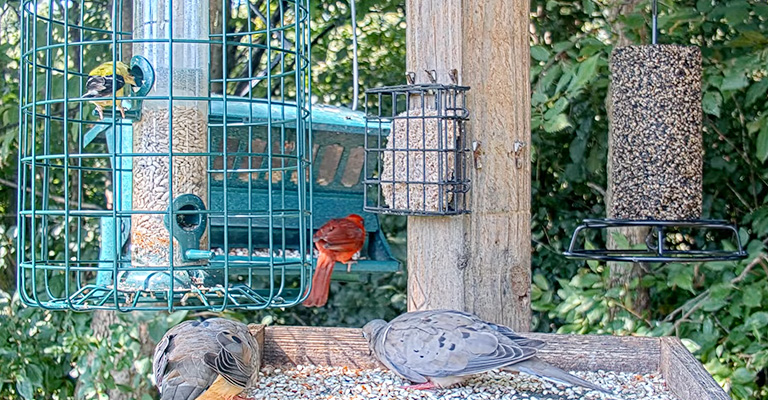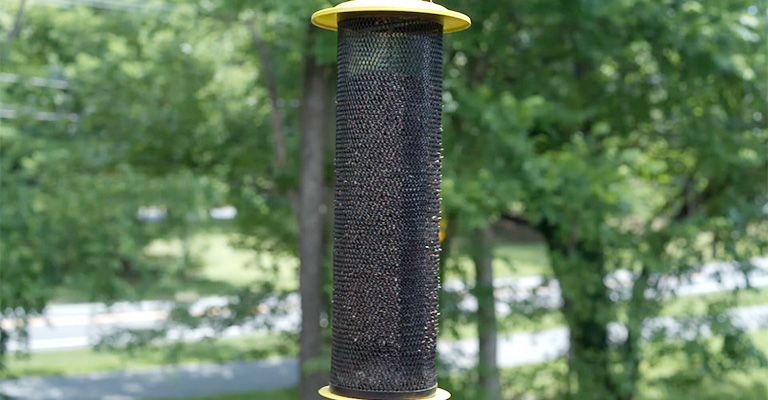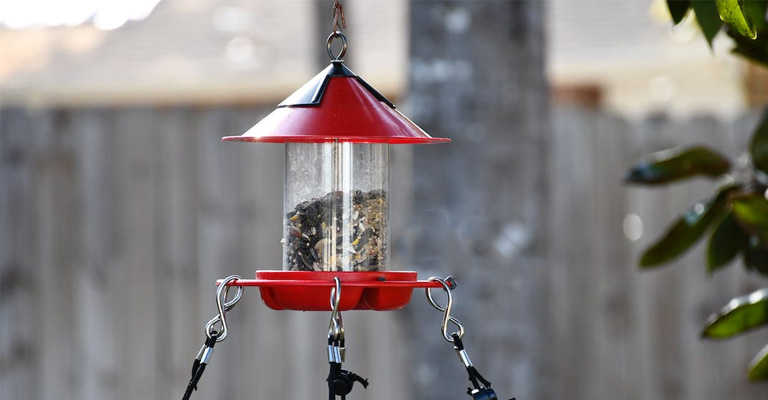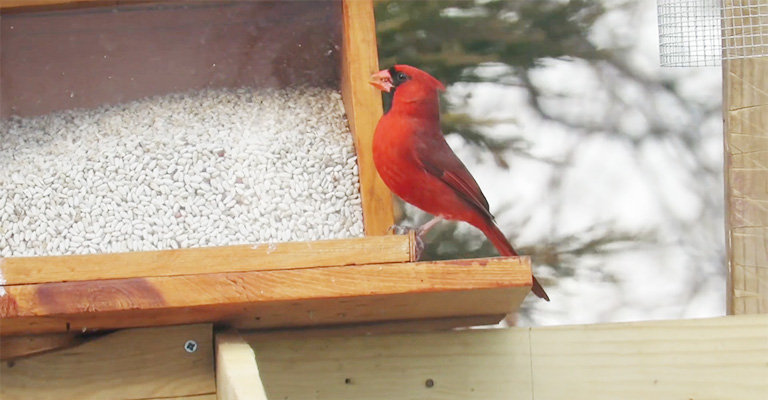The charming presence of cardinals at bird feeders adds a splash of vibrant color to any backyard, but dealing with their monopolization of the feeders can be a concern.
As these striking birds are known to be assertive and territorial, managing their presence becomes a task of balance.
The question of how can I prevent cardinals from hogging my bird feeders requires an understanding of their behavior, along with effective strategies to create an inviting feeding environment for a variety of avian visitors.

How Can I Prevent Cardinals From Hogging My Bird Feeders?
Cardinals are beautiful and popular birds that many people enjoy watching and feeding.
However, they can also be greedy and aggressive and may hog your bird feeders and chase away other birds. If you want to prevent cardinals from hogging your bird feeders, here are some amazing tips that may help:
Use Smaller Feeders
Cardinals are large and heavy birds that can weigh up to 1.8 ounces (50 grams) and have a wingspan of up to 12 inches (30 centimeters).
They prefer large and sturdy feeders that can support their weight and allow them to perch comfortably.
If you use smaller feeders that are designed for smaller birds, such as tube feeders, thistle feeders, or suet feeders, you may discourage cardinals from using them, as they may find them too small or unstable.
Use Different Types Of Seeds
Cardinals are seed-eaters that love sunflower seeds, safflower seeds, cracked corn, and millet. They have strong and thick bills that can crack open large and hard seeds.
If you use different types of seeds that are less appealing or more difficult for cardinals to eat, such as nyjer seeds, peanuts, or nectar, you may attract more variety of birds and reduce the competition from cardinals.
Use Cage Or Mesh Feeders

Cage or mesh feeders are feeders that have a wire or plastic cage or mesh around them, which allows only small birds to enter and access the seeds.
These feeders can prevent cardinals from hogging your bird feeders, as they are too large to fit through the openings.
However, some cardinals may still try to reach the seeds by clinging to the outside of the cage or mesh, so you may need to adjust the size and shape of the openings accordingly.
Use Weight-Activated Feeders
Weight-activated feeders are feeders that have a mechanism that closes the feeding ports when a heavy bird lands on them.
These feeders can prevent cardinals from hogging your bird feeders, as they will be denied access to the seeds when they trigger the mechanism.
However, some cardinals may learn to avoid the mechanism by perching lightly or hanging from the side of the feeder, so you may need to adjust the sensitivity and placement of the mechanism accordingly.
Use Multiple Feeders
Using multiple feeders can help you prevent cardinals from hogging your bird feeders, as it will provide more feeding opportunities and reduce the competition for food.
You can use different types and sizes of feeders and fill them with different types and amounts of seeds. You can also place them at different heights and locations in your yard, such as on poles, trees, fences, or windows.
This way, you can attract a variety of birds and discourage cardinals from dominating one feeder.
Use Baffles Or Guards

Baffles or guards are devices that you can attach to your feeders or poles to prevent cardinals from reaching them.
Baffles are dome-shaped or cone-shaped covers that hang above the feeder or below the pole, which block cardinals from landing on them or climbing up them.
Guards are metal or plastic spikes or wires that stick out from the feeder or pole, which deter cardinals from perching on them or hanging from them.
These devices can prevent cardinals from hogging your bird feeders, as they will make it harder for them to access the seeds.
Use Deterrents Or Repellents
Deterrents or repellents are substances or devices that you can use to scare away cardinals from your bird feeders.
Deterrents are things that make noise or movement, such as bells, wind chimes, pinwheels, flags, or scarecrows, which spook cardinals and make them feel unsafe.
Repellents are things that have a bad taste or smell, such as hot pepper, garlic, vinegar, or soap, which annoy cardinals and make them lose their appetite.
These substances or devices can prevent cardinals from hogging your bird feeders, as they will make it unpleasant for them to stay near them.
Use Decoys Or Predators
Decoys or predators are things that you can use to trick or intimidate cardinals away from your bird feeders.
Decoys are fake birds that look like cardinals’ enemies or rivals, such as hawks, owls, crows, jays, or other male cardinals, which frighten cardinals and make them feel threatened.
Predators are real animals that prey on cardinals, such as cats, dogs, snakes, squirrels, raccoons, or foxes, which chase cardinals and make them feel endangered. These things can prevent cardinals from hogging your bird feeders, as they will make it risky for them to stay near them.
Use Patience And Tolerance
Patience and tolerance are things that you can use to cope with cardinals hogging your bird feeders. Cardinals are beautiful and popular birds that many people enjoy watching and feeding.
They are also beneficial for the environment, as they help to disperse seeds, control pests, and pollinate flowers. They are also intelligent and social animals that have complex behaviors and personalities. Instead of trying to prevent cardinals from hogging your bird feeders, you may want to appreciate them and their role in nature.
You may also want to learn more about them and their habits and try to understand their needs and motivations.
These are some of the tips on how to prevent cardinals from hogging your bird feeders.
What Things Will Keep Cardinals Away From Hogging My Bird Feeders?

Some things that may keep cardinals away from hogging your bird feeders are:
Smaller Feeders
Cardinals are large and heavy birds that prefer large and sturdy feeders that can support their weight and allow them to perch comfortably.
If you use smaller feeders that are designed for smaller birds, such as tube feeders, thistle feeders, or suet feeders, you may discourage cardinals from using them, as they may find them too small or unstable.
Different Types Of Seeds
Cardinals love sunflower seeds, safflower seeds, cracked corn, and millet. They have strong and thick bills that can crack open large and hard seeds.
If you use different types of seeds that are less appealing or more difficult for cardinals to eat, such as nyjer seeds, peanuts, or nectar, you may attract more variety of birds and reduce the competition from cardinals.
Cage Or Mesh Feeders
Cage or mesh feeders are feeders that have a wire or plastic cage or mesh around them, which allows only small birds to enter and access the seeds.
These feeders can prevent cardinals from hogging your bird feeders, as they are too large to fit through the openings.
However, some cardinals may still try to reach the seeds by clinging to the outside of the cage or mesh, so you may need to adjust the size and shape of the openings accordingly.
Weight-Activated Feeders
Weight-activated feeders are feeders that have a mechanism that closes the feeding ports when a heavy bird lands on them.
These feeders can prevent cardinals from hogging your bird feeders, as they will be denied access to the seeds when they trigger the mechanism.
However, some cardinals may learn to avoid the mechanism by perching lightly or hanging from the side of the feeder, so you may need to adjust the sensitivity and placement of the mechanism accordingly.
Multiple Feeders
Using multiple feeders can help you prevent cardinals from hogging your bird feeders, as it will provide more feeding opportunities and reduce the competition for food.
You can use different types and sizes of feeders and fill them with different types and amounts of seeds.
You can also place them at different heights and locations in your yard, such as on poles, trees, fences, or windows. This way, you can attract a variety of birds and discourage cardinals from dominating one feeder.
Baffles or Guards
Baffles or guards are devices that you can attach to your feeders or poles to prevent cardinals from reaching them.
Baffles are dome-shaped or cone-shaped covers that hang above the feeder or below the pole, which block cardinals from landing on them or climbing up them.
Guards are metal or plastic spikes or wires that stick out from the feeder or pole, which deter cardinals from perching on them or hanging from them.
These devices can prevent cardinals from hogging your bird feeders, as they will make it harder for them to access the seeds.
Deterrents or Repellents
Deterrents or repellents are substances or devices that you can use to scare away cardinals from your bird feeders.
Deterrents are things that make noise or movement, such as bells, wind chimes, pinwheels, flags, or scarecrows, which spook cardinals and make them feel unsafe.
Repellents are things that have a bad taste or smell, such as hot pepper, garlic, vinegar, or soap, which annoy cardinals and make them lose their appetite.
These substances or devices can prevent cardinals from hogging your bird feeders, as they will make it unpleasant for them to stay near them.
Decoys or Predators
Decoys or predators are things that you can use to trick or intimidate cardinals away from your bird feeders.
Decoys are fake birds that look like cardinals’ enemies or rivals, such as hawks, owls, crows, jays, or other male cardinals, which frighten cardinals and make them feel threatened.
Predators are real animals that prey on cardinals, such as cats, dogs, snakes, squirrels, raccoons, or foxes, which chase cardinals and make them feel endangered.
These things can prevent cardinals from hogging your bird feeders, as they will make it risky for them to stay near them.
Patience and Tolerance
Patience and tolerance are things that you can use to cope with cardinals hogging your bird feeders. Cardinals are beautiful and popular birds that many people enjoy watching and feeding.
They are also beneficial for the environment, as they help to disperse seeds, control pests, and pollinate flowers. They are also intelligent and social animals that have complex behaviors and personalities.
Instead of trying to prevent cardinals from hogging your bird feeders, you may want to appreciate them and their role in nature. You may also want to learn more about them and their habits and try to understand their needs and motivations.
These are some of the things that may keep cardinals away from hogging your bird feeders.
FAQ
Create a balanced feeding setup. Offer multiple feeders with varying types of food like seeds, suet, and fruit. This encourages different bird species to visit, reducing cardinals’ monopoly on one feeder.
Cardinals favor sunflower seeds, safflower seeds, and cracked corn. Introducing other types of seeds and foods can entice them to share the feeders with other birds.
Yes, using feeders with smaller perches or mesh spacing can discourage larger birds like cardinals while allowing smaller birds to feed comfortably.
Planting shrubs and bushes near the feeders provides cover for smaller birds to feed and helps deter cardinals from monopolizing the area.
Cardinals are most active during the early morning and late afternoon. Adjusting the timing of feeding can help other birds access the feeders without direct competition from cardinals.
Conclusion
The pursuit of harmonious bird feeding that accommodates both cardinals and other species unveils a rewarding journey of observation and adaptation.
Implementing a combination of strategies—such as offering multiple feeders, varying food types, and providing natural cover—can create a well-rounded habitat that caters to diverse bird species.
The quest to prevent cardinals from dominating feeders showcases the delicate interplay between nature’s beauty and our desire to coexist with its inhabitants.
By fostering an inclusive feeding environment, we not only discourage monopolization but also celebrate the rich tapestry of winged visitors that grace our outdoor spaces.